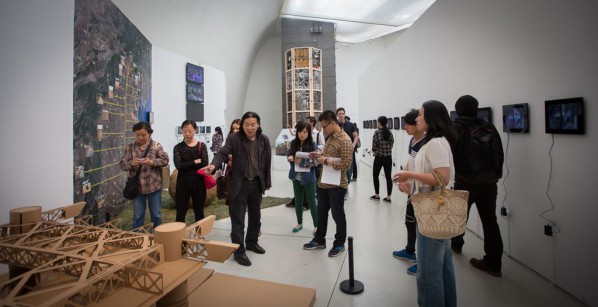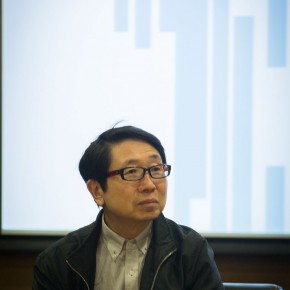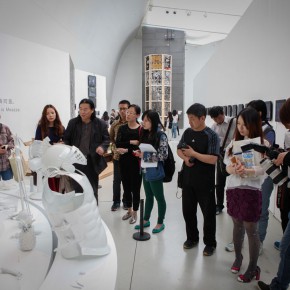
At 3 pm on May 8, 2014, sponsored by the Propaganda Department of CAFA, Press Conference for the “Graduate Exhibition 2014” was held at the CAFA Art Museum. The press conference was hosted by Xu Ping, Director of the Postgraduate Department, CAFA, Gao Hong, Party Secretary of CAFA, Su Xinping, Dean of the School of Plastic, CAFA, Song Xiewei, Deputy Dean of the School of Design, Yin Ji’nan, Dean of the School of Humanities, Wang Huangsheng, Director of CAFA Art Museum, Yue Jieqiong, Director of the Office of Development and Planning, Zhao Wei, a teacher from the Institute of Plastic Arts, Zhao Zhenjiang, representative of Beijing Hanhai Real Estate Investment Group, as well as more than 10 media representatives, including CAFA ART INFO, Artron, 99ys, art China, Jinghua Newspaper, China Art Newspaper, China Daily, China Culture Newspaper, HI art who were invited to attend the conference.
Before the press conference, all media representatives were together and guided to visit the graduate works, and some students on-site introduced their works. In addition, CAFA launched a meeting as an opportunity for an exchange with social enterprises to bridge art students and society, reflecting the inclusive and open academic atmosphere and attitude of CAFA, and the issues that deeply concern the graduates.
This exhibition displays a total of more than 400 works by 307 graduates that are in the Master and Doctor programmes, covering a variety of specialties such as Chinese painting, oil painting, printing, mural painting, sculpture, experimental art, design, architecture, and film. Party Secretary Gao Hong said, it presented the works that are finished in accordance with the requirements of the teaching, thus it was a show of traditional academic achievements of CAFA. The school hopes that through opening to the public, more people can understand the students and teachers, while more opinions and suggestions from society can be heard, to build the interactive and academic research platform.
Curator Wang Huangsheng summarized the development and changes of the graduate exhibition over the three years, first of all, it reflected the effective arrangement of the exhibition works in a short time; secondly the school improved the organization and communication with the students so that it was possible for the students to fully showcase their works; thirdly the works were uniform and completed; fourthly, the exhibition reflected the diversified development and open mind of the academy.
Professor Su Xinping said the School of Plastic had greatly changed and improved, the undergraduate works showed the experimental, conceptuality, and the diversity of methods, while the graduate exhibition embodied the basic educational situation of the CAFA - diversity, reflecting the depth of specialties and especially cross-border ideas, which was in accordance with the requirement of today's artistic development, also fulfilling the needs of the future development.
Professor Song Xiewei does not think design is a traditional discipline limited to the research of a specialty, but has a new understanding and explanation, and he hoped to cultivate and establish a standardized professional rule. Now there are a variety of design disciplines, active thinking on teaching, a subverted function of the material, along with a new explanation which reflects the graduate exhibition. He hoped to keep students sensitive to present life and the future development.
Professor Yin Ji’nan talked about the ideas in the exhibition: firstly the citizens’ democratic consciousness was increasingly strong, instead of the expert’s opinions; secondly, some people said “University is not a chicken farm”, but it was actually difficult to avoid to be one, a graduate exhibition was like “a chicken laying eggs”, but whether it laid eggs, and was good or bad was worth thinking about and an objective evaluation of the issue, while to guarantee the quality of the “chicken farm” there is a reliance on the whole of society; thirdly “plastic for China” was a long-term slogan, “China” was once basically a political concept, which was simple, using personal imagination and plastic measures to complete with the national idea. It contained a complex cultural concept after 1993, and was also faced with the issue of funding, with a “diverse and global horizontal”“cultural China”, some artists had a strong personality that is beyond money, creating rich experimental and imaginative works; some were the best selling goods of a capital subject; and some were in between them. We couldn’t declare whether it is good or not, but only to hope to ensure the virtuous cycle of the basic quality of “chicken farm” in the complex environment.
Representatives of social entrepreneurs Zhao Zhenjiang hoped CAFA can strengthen the communication and interaction with the public, so that more people could understand art.
In the final section of Q & A for the media, it was mainly around diversity, practicality, inheritance of the teachers and students of the graduate works, as well as the future development of the students. Questioning the issue of the inheritance of the teachers and students, Professor Yin Ji-nan said it was undoubtedly a failure for a student to imitate the style and form of the teacher. Director Xu Ping said graduates of the CAFA were basically inclined to be a professional artists, and the school was about to develop a young talent residency program, to support the creation of the outstanding students within two years of graduation.
Journalist: Ye Yuanfeng, Photo: Hu Zhiheng, Quan Jing/CAFA ART INFO
Translated by Chen Peihua and edited by Sue/CAFA ART INFO








































